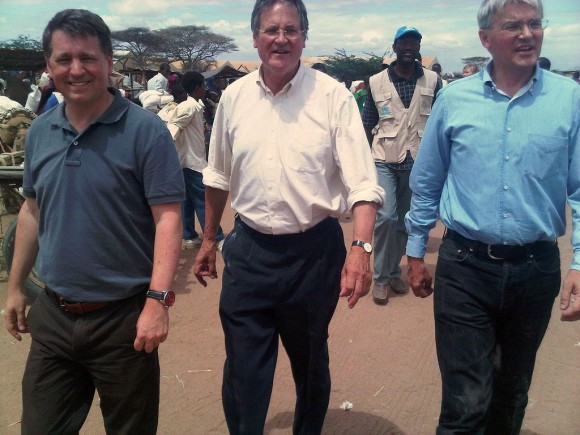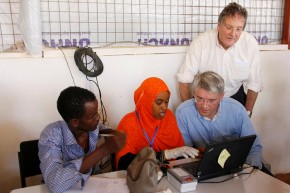
As you fly over this arid, dry and dusty land the vast expanse of tented shelters sprawling across the horizon immediately captures your attention.
There are almost 400,000 people - a number equivalent to the entire population of Bristol - residing in these settlements. On the drive towards the camps of Dabaab you see many new arrivals huddled beneath flimsy makeshift shelters.
It is a tragic sight to behold and a symbol of the painful reality that hundreds of thousands of refugees have had to survive in such harsh conditions. Medics and aid workers are now coping with a huge influx of people who have travelled from the epicentres of the drought and walked for days in desperate search of food.
Alongside these harrowing scenes there are reassuring sights of babies who now have every chance of surviving this catastrophe. But then you notice the sore, blistered feet of the mothers and grandmothers who have trekked for miles to find food and shelter for these infants.
When some of these babies are returned to their families they face a considerable risk of relapsing. The scale of needs means that families are sharing what they have and the most vulnerable suffer when there is not enough food to feed all the family.
Many have travelled from south and central Somalia from regions devastated by drought. The irony of this situation is these survivors are the lucky ones. Those they have left behind are at greater risk.

I was in Somalia in 1992, the last time a famine was declared. All the indicators are that the conditions which I saw and never ever wanted to see again have returned. Charities who have been working in Somalia since the famine of 1992 have not received the support they need and deserve. Their cries for additional help to reach the millions at risk have not been heard.
There is an urgent need to reach the epicentres of this unfolding tragedy. I have come away convinced of the need to warn the international community that this humanitarian emergency must be taken seriously and welcome the UN’s authoritative statement on the famine.
Many of the people arriving in Dabaab are from Somalia’s most productive farming areas. Areas that should be the last line of defence against drought. But now the situation is so severe that even these resilient farmers have taken to the road in search of food and water. If farmers who have exploited these flood plains for generations are on the move, this is a terrible sign of the consequences of this disaster.
As I travelled through Wajir in north-eastern Kenya, it became clear that the needs of many villages in this region are just as acute those in Dadaab. In addition to getting life-saving aid into southern and central Somalia, we need a massive parallel expansion of relief in northern Kenya.
I was incredibly moved to see the dedication of Kenyan nurses in the nutrition centres in Dadaab and Wajir. These nurses and their international colleagues were for keen for us to tell the story of this tragic, unfolding crisis to rally the world’s compassion.
Brendan Gormley is Chief Executive of the UK's Disasters Emergency Committee (DEC). He travelled to the Dadaab camp with International Development Secretary Andrew Mitchell and Chief Executive of Save the Children, Justin Forsyth. DEC unites the 14 leading UK aid agencies in their efforts to finance relief for people suffering major disasters in poorer countries.
How can you help? Make a donation to DEC's East Africa Crisis Appeal now:
Donate to DEC's East Africa Crisis Appeal
Get the latest updates on the situation in Horn of Africa:
Horn of Africa food crisis: latest news
Find out more about the impact of the food crisis and the aid that DEC members are providing:
See the interactive appeal map
See more pictures from the Dadaab visit on Flickr:
View more pictures from the visit
Please note, this is a guest blog. Views expressed here do not necessarily represent the views of DFID or have the support of the British Government.

3 comments
Comment by Nick posted on
Such a sad situation, it is good to see things progressing positively but you must always wonder why they are allowed to get this bad in the first place. Nice update, thanks
Comment by guncel posted on
I agree with Nick. It s a really meaningful subject about the camps in Africa. All the poor people need the humans help day to day .We should increase the helps for the countries such as Somaila and South Africa...
Comment by weston khisa posted on
I lost my comment but will try and write it again however it is sad. I write from Garissa hospial in Kenya near Dadaab refugee. i have been here for a week now repairing young refugee fistula patients. Very sad stories indeed. The world must wake up to this call.